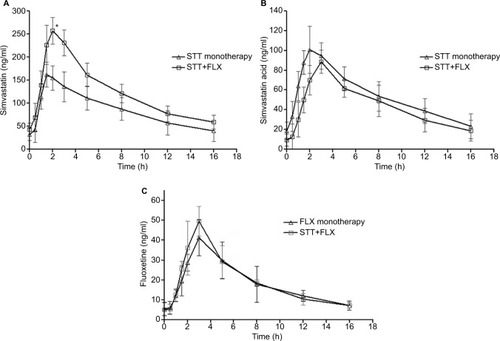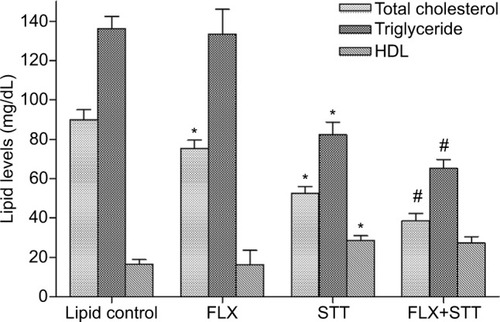Figures & data
Figure 1 Mean plasma levels of STT, STA, and FLX after single and combined administration of STT and FLX. Time course for (A) STT plasma levels, (B) STA plasma levels, and (C) FLX plasma levels after single administration of STT at a dose of 40 mg/kg b.w. and FLX at a dose of 20 mg/kg b.w. and combined administration of STT with FLX for a period of 4 weeks. Results are expressed as mean±SD; n=3 (three animals per time points). FLX administered simultaneously with STT was able to increase the plasma concentration of STT. Significant difference at the Cmax level was observed with combined treatment. *p<0.05, compared to STT alone.

Table 1 Pharmacokinetic profile of STT, STA, and FLX in plasma of Wistar rat after treatment with different regimens (data are represented as mean±SD)
Figure 2 Brain concentration–time profile of (A) STT, (B) STA, and (C) FLX obtained after oral administration of FLX and STT, alone and in combination, to Wistar rats for a period of 4 weeks. The data are represented as mean±SD; n=3. Combined administration of STT with FLX led to a significant increase in the level of STT in brain in comparison to STT monotherapy (p<0.05). However, STT did not alter the brain concentration of FLX up to a significant level. *p<0.05, compared to STT alone.

Table 2 Pharmacokinetic profile of STT, STA, and FLX in the brain of Wistar rats after treatment with different regimens (data are represented as mean±SD)
Figure 3 Bar graph of cholesterol, triglyceride, and HDL plasma concentrations in Wistar rats after the treatment with FLX and STT alone and their combination for a period of 4 weeks. The data are presented as mean±SD; n=6. Significant differences were observed between the lipid control and the other experimental groups. There was a significant decrease in cholesterol levels in the animals treated with FLX alone. Significant improvement in lipid profile was observed when STT was administered along with FLX. FLX alone did not affect the level of triglyceride or HDL, but in combination with STT, exerted a synergistic effect in reducing cholesterol and triglyceride level. *p<0.05, compared to lipid control; #p<0.05, compared to STT alone.

Figure 4 Levels of neurotransmitters in Wistar rat brain after the combined and separate treatment with FLX and STT for 4 weeks. STT significantly increased 5HT level in the brain when administered alone and produced a synergistic effect in combination with FLX, whereas it did not alter the level of dopamine up to a significant level. Furthermore, FLX produced significant increases in the brain level of dopamine and 5HT after 4-week systemic administrations. In addition, both of these drugs failed to alter the concentration of HIAA up to a significant level. The data are presented as mean±SD; n=6. *p<0.05, compared to lipid control; #p<0.05, compared to FLX alone.

